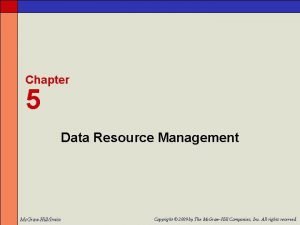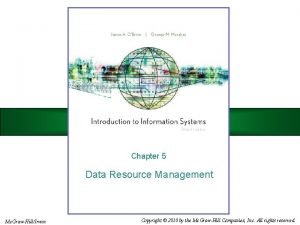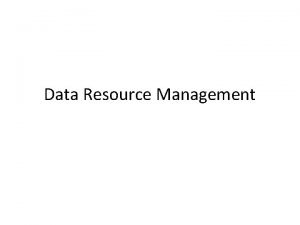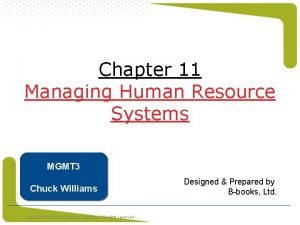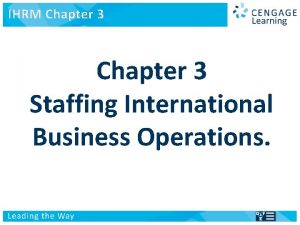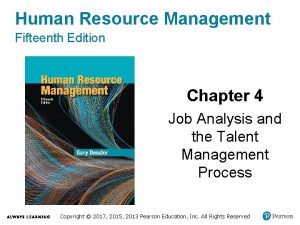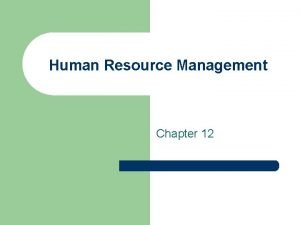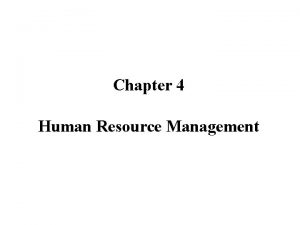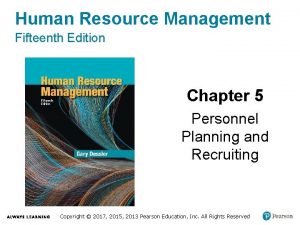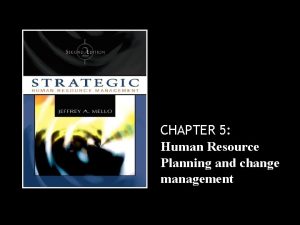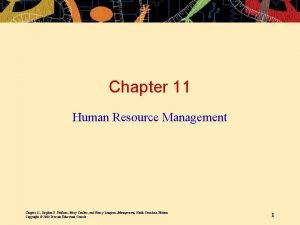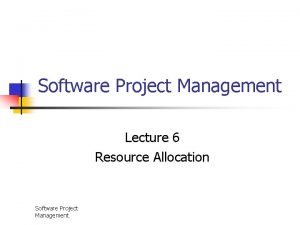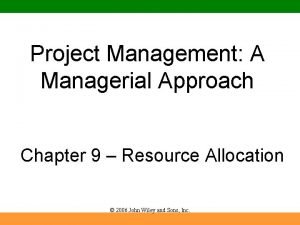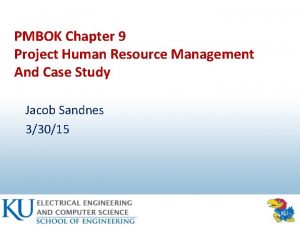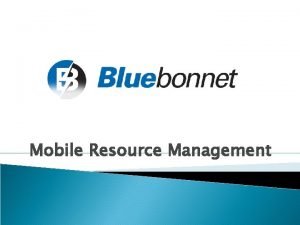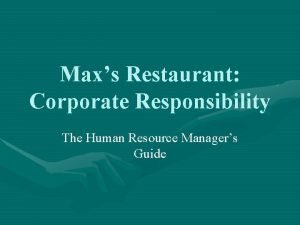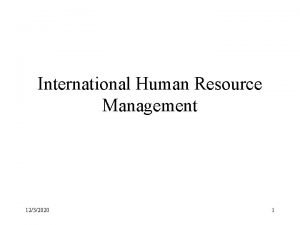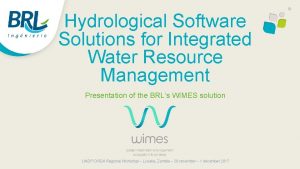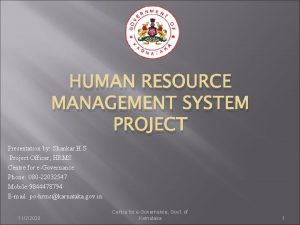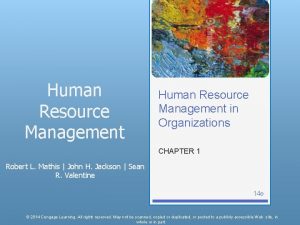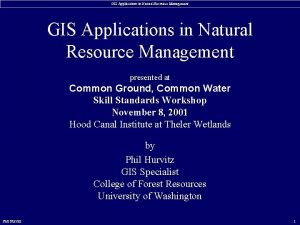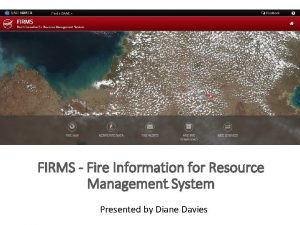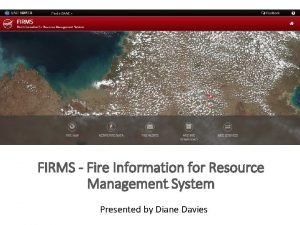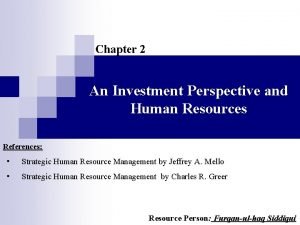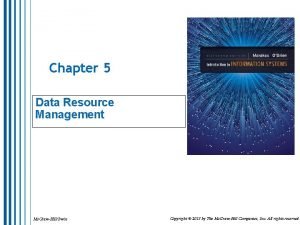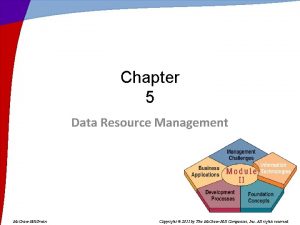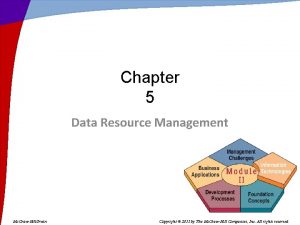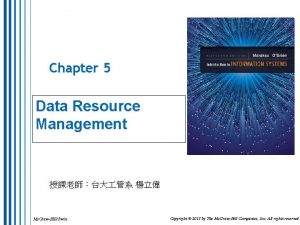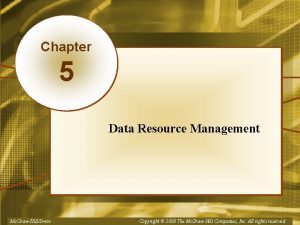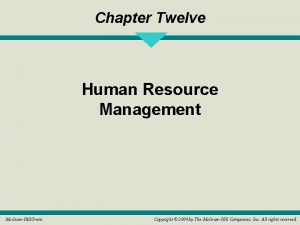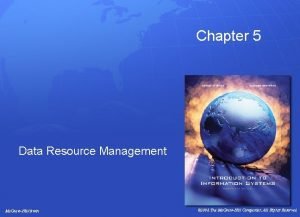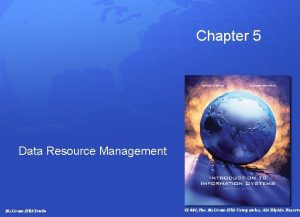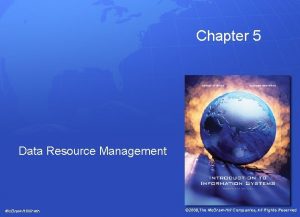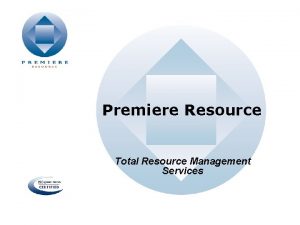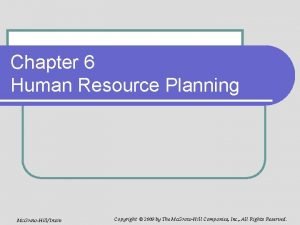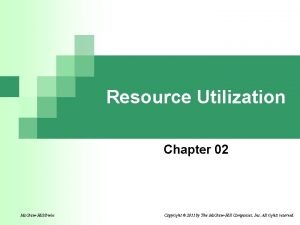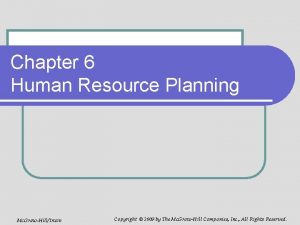Chapter 5 Data Resource Management Mc GrawHillIrwin Copyright


























































- Slides: 58

Chapter 5 Data Resource Management Mc. Graw-Hill/Irwin Copyright © 2010 by the Mc. Graw-Hill Companies, Inc. All rights reserved.

Learning Objectives l Explain the business value of implementing data resource management processes and technologies in an organization l Outline the advantages of a database management approach to managing the data resources of a business, compared with a file processing approach l Explain how database management software helps business professionals and supports the operations and management of a business 5 -2

Learning Objectives l Provide examples to illustrate the following concepts – Major types of databases – Data warehouses and data mining – Logical data elements – Fundamental database structures – Database development 5 -3

Fundamental Data Concepts 5 -4

Database Management l In all Information Systems, data resources must be organized in a logical manner so that: 1 - They can be accessed easily 2 - Processed efficiently 3 - Retrieved quickly 4 - Managed effectively 5 -5

Logical Data Elements 5 -6

Logical Data Elements Character • A single alphabetic, numeric, or other symbol Field (data item) • a grouping of related characters • Represents an attribute (quality or characteristic) of some entity (object, person, place, event) Record • Grouping of all the fields used to describe the attributes of an entity • Example… payroll records with name, SSN, pay rate • Examples… salary, job title 5 -7

Logical Data Elements File (table, flat file) • Group of related records Database • Integrated collection of logically related data elements 5 -8

Electric Utility Database 5 -9

Database Structure 5 -10

Database Structures 1. Hierarchical 2. Network 3. Relational 4. Object-oriented 5. Multidimensional 5 -11

Common Database Structures: Hierarchical – – Early DBMS structure Records arranged in tree-like structure Relationships are one-to-many Access data elements by moving progressively downward from the root and along the branches of the tree 5 -12

Common Database Structures: Network – Used in some mainframe DBMS packages – Many-to-many relationships l Any data element can be related to any number of other data elements 5 -13

Common Database Structures: Relational l Most widely used structure – Data elements are stored in tables – Row represents a record; column is a field – Can relate data in one file with data in another, if both files share a common data element 5 -14

Relational operations l Relational operations include: – Select… l l Create a subset of records that meet a stated criterion. Example: employees earning more than $30, 000 – Join… l Combine two or more tables temporarily. l Looks like one big table. – Project… l Create a subset of columns in a table 5 -15

Common Database Structures: Multidimensional l Variation of relational model – Uses multidimensional structures to organize data – Data elements are viewed as being in cubes – Popular for analytical databases that support Online Analytical Processing (OLAP) 5 -16

Multidimensional Model 5 -17

Common Database Structures: Object-Oriented Source: Adapted from Ivar Jacobsen, Maria Ericsson, and Ageneta Jacobsen, The Object Advantage: Business Process Reengineering with Object Technology (New York: ACM Press, 1995), p. 65. Copyright @ 1995, Association for Computing Machinery. By permission. 5 -18

Common Database Structures: Object-Oriented l An object consists of – Data values describing the attributes of an entity – Operations that can be performed on the data l Encapsulation – Combine data and operations l Inheritance – New objects can be created by replicating some or all of the characteristics of parent objects l Used in object-oriented database management systems (OODBMS) l Supports complex data types more efficiently than relational databases – Examples: graphic images, video clips, web pages 5 -19

Evaluation of Database Structures Hierarchical • Works for structured, routine transactions • Can’t handle many-to-many relationship • Unable to handle ad hoc requests Network Relational • More flexible than hierarchical • Easily responds to ad hoc requests • Unable to handle ad hoc requests • Easier to work with & maintain • Not as efficient or quick as hierarchical or network 5 -20

Database Development Database Administrator (DBA) In charge of enterprise-wide database development Improves integrity and security of organizational databases Uses Data Definition Language (DDL) to develop and specify data content, relationships, and structure Stores these specifications in a data dictionary or metadata repository 5 -21

Data Dictionary Contains data about data (metadata) Relies on specialized software component to manage a database of data definitions Can be active or passive Contains information on… Names and descriptions of all types of data records and their interrelationships Requirements for end users’ access and use of applications Database maintenance Security 5 -22

Example of a Data Dictionary 5 -23

Data Resource Management l Data resource management is a managerial activity – Uses data management, data warehousing, and other IS technologies – Manages data resources to meet the information needs of business stakeholders 5 -24

Case 2: Applebee’s, Travelocity, and Others l Applebee’s – Uses data for basic business decisions, such as replenishing food supplies based on how much finished product was sold daily – Developing more sophisticated analyses that look at how well items are selling l l This will help the company make better decisions about what to order and what products to promote Today, organizations extensively aggregate and mine their data to make better decisions – Travelocity mined 600, 000 comments so it could better monitor and respond to customer issues 5 -25

Case Study Questions l What are the business benefits of taking the time and effort required to create and operate data warehouses such as those described in the case? – – l Do you see any disadvantages? Is there any reason why all companies shouldn’t use data warehousing technology? Applebee’s noted some of the unexpected insights obtained from analyzing data about “back-of-house” performance – Using your knowledge of how a restaurant works, what other interesting questions would you suggest to the company? 5 -26

Case Study Questions l Data mining and warehousing technologies use data about past events to inform better decisionmaking in the future – Do you believe this stifles innovative thinking, causing companies to become too constrained by the data they are already collecting to think about unexplored opportunities? 5 -27

Types of Databases 5 -28

Operational Databases Stores detailed data needed to support businesses and operations Also called subject area databases (SADB), transaction databases, and production databases Database examples: customer databases, human resource databases, inventory databases 5 -29

Distributed Databases Distributed databases are copies or parts of databases stored on servers at multiple locations Protection of valuable data Data can be distributed into smaller databases Each location has control of its local data All locations can access any data, anywhere Improved database performance at worksites Maintaining data accuracy Advantages Disadvantages 5 -30

Distributed Databases Updating data can be done in 2 ways: Replication Look at each distributed database and find changes Apply changes to each distributed database Very complex Duplication One database is master Duplicate the master after hours, in all locations Easier to accomplish Requires extra computing power & bandwidth 5 -31

External Databases available for a fee from the Web, or from commercial online services Hypermedia databases Statistical databases Bibliographic and full-text databases Search engines like Google or Yahoo are external databases 5 -32

Components of Web-Based System l A hypermedia database contains – Website database – Consist of hyperlinked pages of multimedia – Interrelated hypermedia page elements, rather than interrelated data records 5 -33

Data Warehouses Stores static data that has been extracted from other databases in an organization Central source of data that has been cleaned, transformed, and cataloged Data is used for data mining, analytical processing, analysis, research, decision support Data warehouses may be divided into data marts Subsets of data that focus on specific aspects of a company (department or process) 5 -34

Data Warehouse Components 5 -35

Applications and Data Marts 5 -36

Data Mining 5 -37

Data Mining l Data in data warehouse are analyzed to reveal hidden patterns and trends Examples: – Perform market-basket analysis to identify new business processes – Find root causes to quality problems – Cross sell to existing customers – Profile customers with more accuracy 5 -38

5 -39

Data Mining 5 -40

Traditional File Processing Data are organized, stored, and processed in independent files Each business application uses specialized data files containing specific types of data records Problems Data redundancy Lack of data integration Data dependence (files, storage devices, software) Lack of data integrity or standardization 5 -41

Traditional File Processing - Banks 5 -42

Database Management Approach The foundation of modern methods of managing organizational data Consolidates data records, formerly in separate files, into databases Data can be accessed by many different application programs A database management system (DBMS) is the software interface between users and databases 5 -43

Database Management Approach 5 -44

Database Management System In mainframe and server computer systems, database management software is used to… Create new databases and database applications Maintain the quality of the data in an organization’s databases Use the databases of an organization to provide the information needed by end users 5 -45

Common DBMS Software Components 5 -46

Database Management System l Database Development – Defining and organizing the content, relationships, and structure of the data needed to build a database l Database Application Development – Using DBMS to create prototypes of queries, forms, reports, Web pages l Database Maintenance – Using transaction processing systems and other tools to add, delete, update, and correct data 5 -47

DBMS Major Functions 5 -48

Database Interrogation End User Makes DBMS Query No programming required Query Language Immediate response to ad hoc data requests Report Generator Quickly specify a format for information you want to present as a report Response is a video display or a printed report 5 -49

Database Interrogation l SQL Queries – Structured, international standard query language found in many DBMS packages – Query form is SELECT…FROM…WHERE… 5 -50

Database Interrogation l Boolean Logic – Developed by George Boole in the mid-1800 s – Used to refine searches to specific information – Has three logical operators: AND, OR, NOT l Example – Cats OR felines AND NOT dogs OR Broadway 5 -51

Database Interrogation Graphical and Natural Queries It is difficult to correctly phrase SQL and other database language search queries Most DBMS packages offer easier-to-use point-and-click methods Translates queries into SQL commands Natural language query statements are similar to conversational English 5 -52

Microsoft Query Wizard 5 -53

Database Maintenance l Accomplished by transaction processing systems and other applications, with the support of the DBMS – Done to reflect new business transactions and other events – Updating and correcting data, such as customer addresses 5 -54

Application Development Use DBMS software development tools to develop custom application programs Not necessary to develop detailed datahandling procedures using conventional programming languages Can include data manipulation language (DML) statements that call on the DBMS to perform necessary data handling 5 -55

Case 3: Amazon, e. Bay, and Google l Amazon’s data vault – Product descriptions – Prices – Sales rankings – Customer reviews – Inventory figures – Countless other layers of content 10 years & $1 billion to build 5 -56

Case 3: Amazon, e. Bay, and Google l Amazon opened its data vault in 2002 – 65, 000 developers, businesses, and entrepreneurs have tapped into it – Many have become business partners l e. Bay opened its $3 billion databases in 2003 – 15, 000 developers and others have registered to use it and to access software features – 1, 000 new applications have appeared – 41 percent of e. Bay’s listings are uploaded to the site using these resources 5 -57

Case 3: Amazon, e. Bay, and Google l Google recently unlocked access to its desktop and paid-search products – Dozens of Google-driven services cropped up – Developers can grab 1, 000 search results a day for free; anything more requires permission – In 2005, the Ad-Words paid-search service was opened to outside applications 5 -58
 Resource leveling is the approach to even out the peaks of
Resource leveling is the approach to even out the peaks of Perbedaan resource loading dan resource levelling
Perbedaan resource loading dan resource levelling Data resource management
Data resource management Data resource management
Data resource management Apa itu data resource management
Apa itu data resource management Time management in human resource management
Time management in human resource management Hrm in retail
Hrm in retail Management is universal and everywhere
Management is universal and everywhere Human resource management chapter 2
Human resource management chapter 2 Chapter 9 human resource management
Chapter 9 human resource management Chapter 11 human resource management
Chapter 11 human resource management Chapter 11 forestry and resource management
Chapter 11 forestry and resource management Battling over clayoquot big trees
Battling over clayoquot big trees Chapter 1 introduction to human resource management
Chapter 1 introduction to human resource management Human resources introduction
Human resources introduction Human resource management lecture chapter 1
Human resource management lecture chapter 1 Human resource management lecture chapter 1
Human resource management lecture chapter 1 Virtual assignment in ihrm
Virtual assignment in ihrm Chapter 4 job analysis and the talent management process
Chapter 4 job analysis and the talent management process Chapter 12 human resource management
Chapter 12 human resource management Chapter 7 human resource management
Chapter 7 human resource management Chapter 7 human resource management
Chapter 7 human resource management Human resource management chapter 4
Human resource management chapter 4 Project management chapter 4
Project management chapter 4 Replacement chart example
Replacement chart example Human resource management chapter 5
Human resource management chapter 5 Chapter 11 human resource management
Chapter 11 human resource management Tivoli storage resource manager
Tivoli storage resource manager Resource requirements example
Resource requirements example Microsoft project server resource management
Microsoft project server resource management Resource levelling in project management
Resource levelling in project management Resource management pmp
Resource management pmp Project human resource management pmbok
Project human resource management pmbok Mobile resource management solution
Mobile resource management solution The importance of resource management
The importance of resource management Restaurant human resources
Restaurant human resources Explain the concept of human resource management
Explain the concept of human resource management Purpose of induction
Purpose of induction Water resource management software
Water resource management software Human resource management system project ppt
Human resource management system project ppt Performance appraisal in human resource management
Performance appraisal in human resource management Current issues in human resource management
Current issues in human resource management Ba human resource management
Ba human resource management Purpose of human resource management
Purpose of human resource management Human resource management gaining a competitive advantage
Human resource management gaining a competitive advantage Human resource management gaining a competitive advantage
Human resource management gaining a competitive advantage Human resource management gaining a competitive advantage
Human resource management gaining a competitive advantage Sample hrm exam questions
Sample hrm exam questions Management fifteenth edition
Management fifteenth edition Human resource management by gary dessler 11th edition
Human resource management by gary dessler 11th edition Strategic human resource
Strategic human resource Gis hrm
Gis hrm Nasa's fire information for resource management system
Nasa's fire information for resource management system Fire information for resource management system
Fire information for resource management system Fire information for resource management system
Fire information for resource management system Importance of water
Importance of water Investment perspective of hr
Investment perspective of hr Managing information technology resources
Managing information technology resources What are the objectives of bridge resource management?
What are the objectives of bridge resource management?


